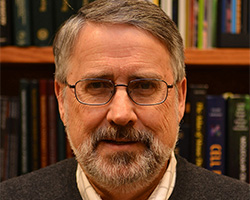Mechanical role of elastic fibers in tendons to get closer look
Spencer Lake and Robert Mecham lead a team using imaging to study function of elastin in tendons

Tendons, which connect muscle to bone, are made up primarily of collagen fibers, but also contain a network of elastic fibers that may be important for transferring force and in resisting fatigue. A team of researchers at Washington University in St. Louis plans to use imaging to take a closer look than has previously been possible at the mechanical role of elastic fibers in tendons.
Spencer Lake, associate professor of mechanical engineering & materials science in the McKelvey School of Engineering, and Robert Mecham, the Alumni Endowed Professor of Cell Biology and Physiology and an affiliate faculty member in biomedical engineering in McKelvey Engineering, will use a quantitative imaging technique and mechanical testing to study tendons from a novel mouse model with a three-year, $454,261 grant from the National Science Foundation. The new research builds on previous work in Lake’s lab that suggested an important role for elastic fibers in providing functional strength to tendons.
Using two-photon imaging that takes advantage of a pulsed infrared laser to acquire high-quality 3D images, Lake and his team will study tissues from mice that lack elastic fibers in their tendons to observe the impact on mechanics, such as how they handle dynamic loading and fatigue. While the imaging technique is not new, Jeremy Eekhoff, a doctoral student in Lake’s Musculoskeletal Soft Tissue Lab, has made several adjustments to the approach that will allow them to see deeper into the tissue. Eekhoff adapted a tissue-clearing protocol in which the researchers exchange the water in the tissue for a solution that more closely matches the optical properties of the tendon.
“Our new imaging technique is critical because we can now image several hundred microns deep, which in the mouse tendon, allows us to image all the way through the tissue,” Lake said. “We can use this method to understand how elastin is organized in different genetically-modified mouse models, as well as in section of tendons from larger species such as human and cow.”
Lake and the team will look at the Achilles tendon and the tibialis anterior tendon (TBAT) from mice and humans and the superficial digital flexor tendon and long digital extensor tendon from cows. Since the tendons in mice are so small, using the tendons from larger species will provide a better view of the elastin in the interfascicular matrix where elastic fibers are more densely concentrated.
“Tendons are quite different depending on their functional demands,” Lake said. “The Achilles tendon is a high-energy, dynamic tendon, while the TBAT is more of a stabilizing, positional tendon. We’ve seen thus far that energy-storing tendons have more elastin, which we think is playing a larger role in those tendons than in the stabilizing, positional ones."
For the outreach element of the project, Lake plans to share the imaging technique with other Washington University researchers and create a workshop for researchers at local universities where data and ideas can be shared. In addition, he will work with students from Pattonville High School’s Biomedical Science Program to provide opportunities for hands-on training and to complete a senior project in his lab.





